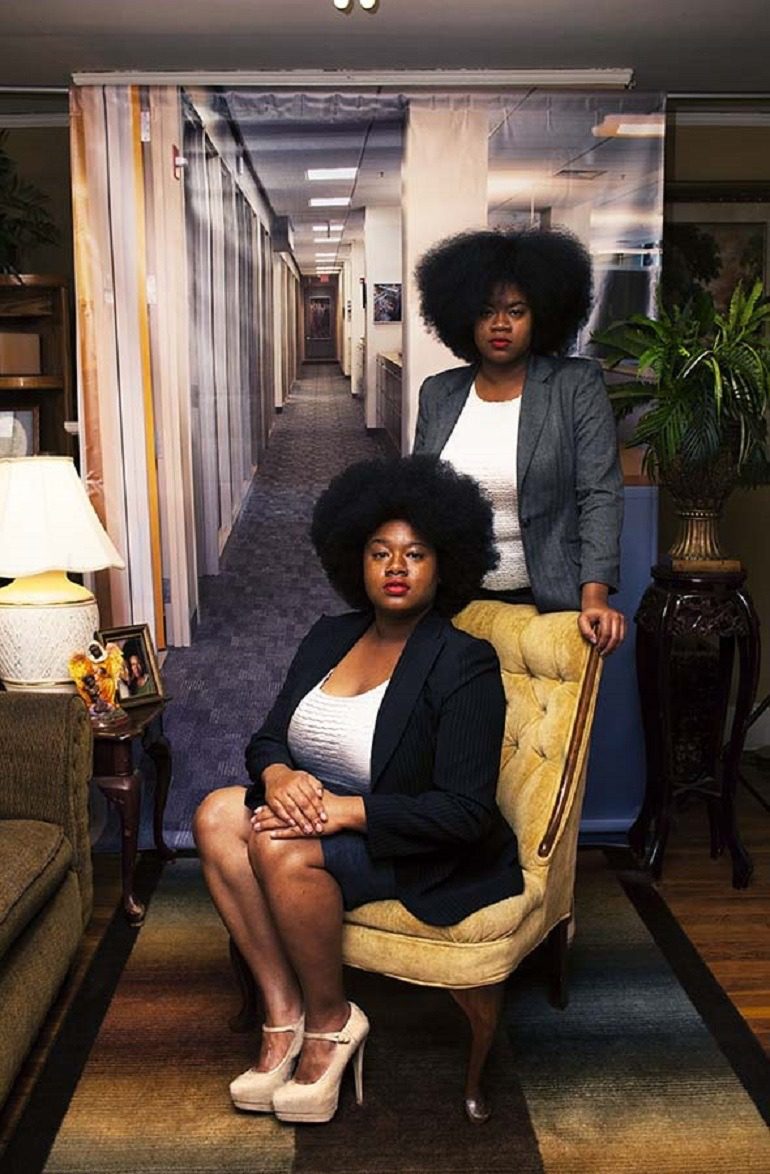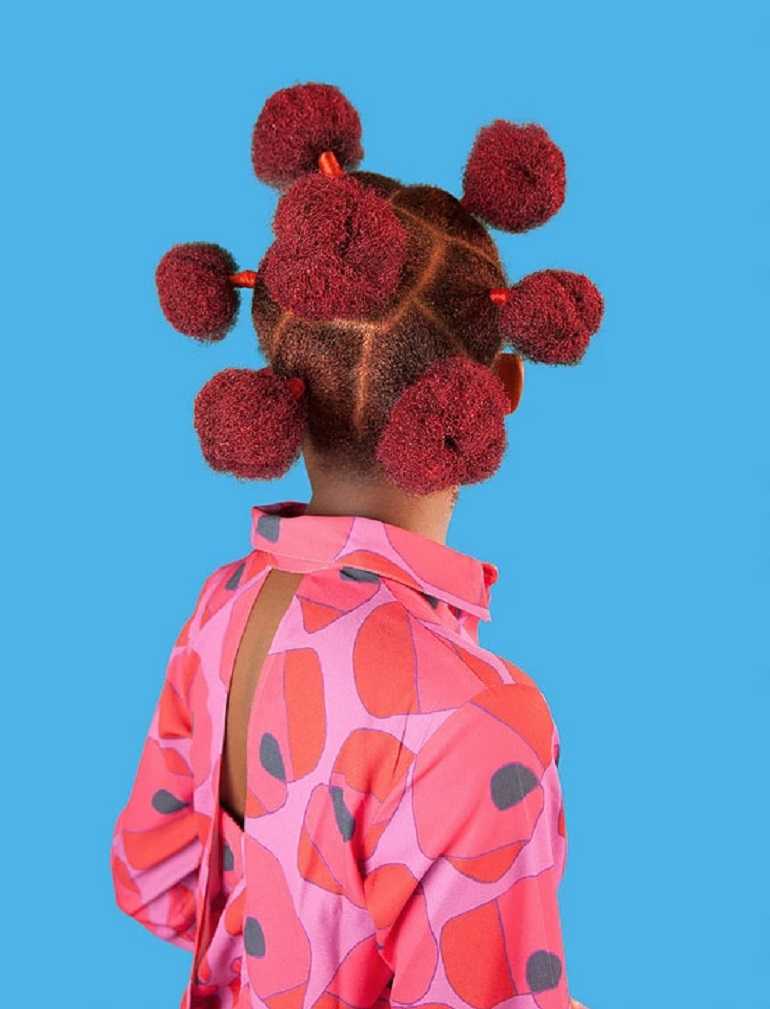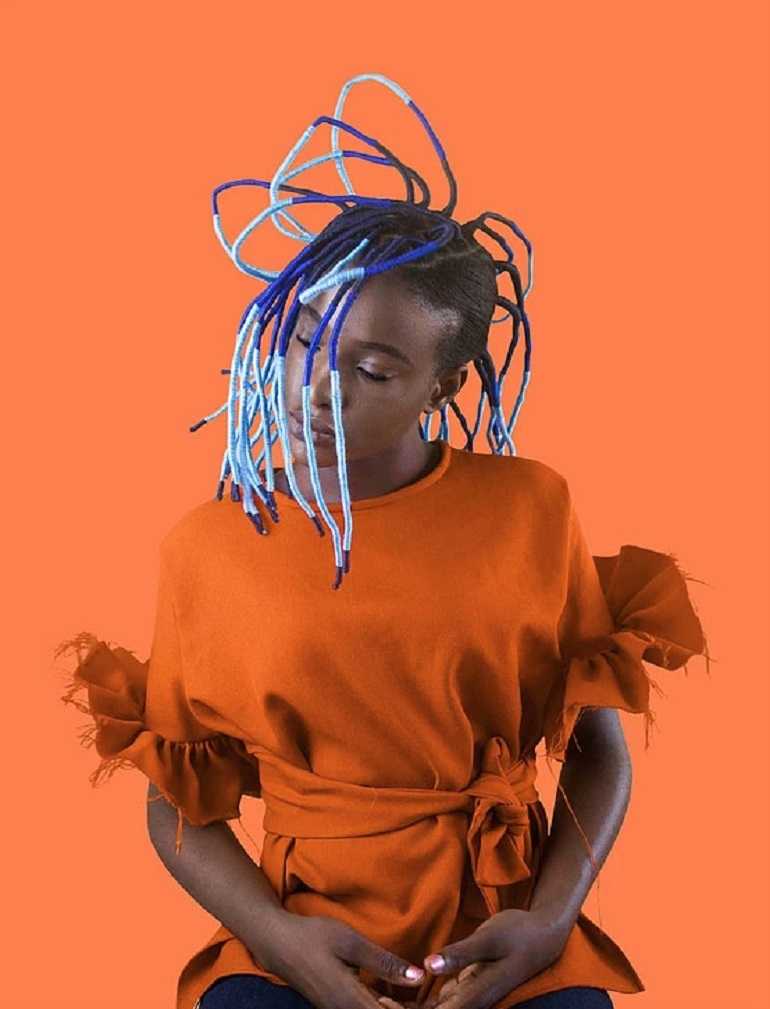ART NEWS
Saint Sugar Hill by Alanna Airitam, from The Golden Age series, addresses how black women are represented in Western art. Image: Catherine Edelman Gallery
ART REVIEW: In their recent photographs on display at Catherine Edelman Gallery, Alanaa Airitam, Endia Beal, and Medina Dugger take on how black women are perceived in art, the workplace, and through their physical appearance.
BY KAZEEM ADELEKE
CHICAGO- The way black women are perceived in art, the workplace, and through their physical appearance is at the center of a new show at Catherine Edelman Gallery in Chicago. The exhibition is titled How do you see me? It features photographs by Alanna Airitam, Endia Beal, and Medina Dugger.
Presented in a unique and non-traditional manner, the photographs question racial stereotypes and biases prevalent in history books and continue to permeate society today. Through these important photographs, the artists challenge the perception of beauty and the different standards that exist based on skin color.
A core issue in many of the photographs is how black women’s hairstyles affect how they are perceived in different spaces, including the corporate environment. Are black women discriminated against because of their hairstyles? This is one of the fundamental questions raised by these photographers through their images of black women. Other topics raised in the images include fashion, style, and personal appearance.
Alanna Airitam: Black Women in Western Art
The representation of dark-skinned people in Western art has been the subject of discussion among art scholars for many years. In paintings and films, Colored people are depicted as domestic workers, slaves, or barbarians. That is if they are represented at all.
When Alanna Airitam was studying the history of art, she became aware of this art history and decided to reclaim it by forcefully inserting the images of African Americans into the art discourse through a series she calls The Golden Age.
Racial Disparity in Western Art
The Golden Age shines a light on the racial disparity evident in Western art history. For this series, Alanna invites African Americans to pose in the style of classic Dutch portraiture. Each image is carefully staged to reflect places in Harlem, including Saint Sugar Hill, Saint Minton, and Saint Lenox. In addition to highlighting the racial disparity in Western art, the series also celebrates the Harlem Renaissance, which paved the path for many young African Americans working today.
Saint Sugar Hill, 2017, is a portrait of a woman wearing a flowing white robe sitting on a sofa. In her right hand is a pear, while a staff leans on the left-hand rest. The woman intensely gazes at the pear as if contemplating its lusciousness. On the woman’s stomach is a bunch of red grapes near a string of beads. The woman’s hair is decorated with some leaf ornaments, complimenting her nobleness. This is a woman of status, and the picture shows it.
With Saint Sugar Hill, Alanna contests the representation of black women in Western art history by elevating them to the place of nobility. All the works in The Golden Age series are meticulously put together to celebrate black identity even as they highlight the racial divide that exists throughout art history. Black men and women are depicted with dignity in a way that challenges Western art’s hegemonic racial history.
Endia Beal: Black Women in the Corporate World

Endia Beal, Sabrina, and Katrina, 2015. From the Am I What You’re Looking For series. 40 x 30″ pigment print. Edition of 3. Image: Catherine Edelman Gallery
Endia Beal’s photographs have a foundation in her personal experience. As a young black woman in a mostly white-dominated corporate job, Beal was always self-conscious of how she was perceived by her colleagues. She knew she was the center of discussion for others, not just because of her academic excellence but also because of her hair, which did not conform to their definition of beauty.
Black Women’s Hairstyles in the Corporate Space
Black women’s hairstyles in the corporate environment have been the focus of controversy for many years. Many black women have complained about discrimination from employers who overlook them for employment because of their afros, twists, or braids. They contend that while black women with straightened hair, white women with straight hair, or white women with curly hair are often considered, they are ignored because of their natural-looking hairstyles.
A recent study from Duke University’s Fuqua School of Business has finally confirmed the complaints by black women who said they have been discriminated against by employers because of their hairstyles. The research that included involved hundreds of participants of different races concluded that black women with natural hair, including afros, twists, or braided hairstyles are often discriminated against in industries considered conservative.
However, discrimination does not end at the entry level. For black women who are able to wiggle through the door, discrimination continues in the corporate environment. In the corporate space, Black women are discriminated against for their nonconformist hairstyles and fashion sensibilities. Beal had that experience as a young black woman working in a mostly white-dominated corporate job.
That experience formed the foundation for her recent work, in which she addresses how black women are viewed in the corporate world based on their physical appearance. She calls her series on this issue Am I What You’re Looking For? For this series, Endia poses black women in front of a photographic backdrop of a typical office setting, wearing outfits they find suitable for work.
Black Women: Fashion Sensibilities
Sabrina and Katrina (2015) is a photograph of two black women–one sitting and another standing– in an office space. The women have afro hairstyles. They are also wearing camisoles and well-cut blazers to match. The seated woman allows a better look at the way the women are dressed. In addition to the afro hairstyle, the woman is wearing a black knee-length skirt and gray high heels.
From the women’s body language, it is clear that these are proud black women. This common thread runs through Beal’s work. Her photographs tell stories of black women who are unique in their styles. In works like Melanie (2016), Kennedy (2015), Christian (2016), and Tianna (2016), Beal reveals beautiful black women proud of who they are. They are individuals with well-articulated styles and self-expression.
Beal is astute in her depiction of bold, beautiful, and stylish black women who can hold their own anywhere. But even as she celebrates black women, she interrogates how these women are perceived in the work environment. With her photographs, Beal raises questions about the stereotypes that black women face when they do not fit the corporate mold and the expectation that black women should conform to a strict tradition.
Beal’sphotographs challenge viewers to look at their own biases or stereotypes as they view the photographs. The insightful photographs extend Beal’s quest to bring attention to how black women are perceived in the workplace. A professor at Winston Salem State University, she confronts the stereotypes that her students face as they forcefully insert their individual styles and personality into a biased corporate environment.
Medina Dugger: Celebrating J.D. ‘Okhai Ojeikere
Medina Dugger draws her inspiration from celebrated Nigerian photographer J.D. ‘Okhai Ojeikere, who for more than 40 years made documenting Nigerian hairstyles the focus of his photography career. Traveling across Nigeria and other African countries, he visited homes, weddings, birthday parties, and other events to capture unique hairstyles across Nigerian culture.

Medina Dugger, Pink Buns, 2017. From the Chroma series 24 x 18, 48 x 36″ pigment print. Edition of 5 + 2APs, 5 + 2APs. Image: Catherine Edelman Gallery.
J.D. ‘Okhai Ojeikere’s photographs are significant on so many levels. Many of them were taken at a period when Nigerians were confronting colonialism and the invasion of Western culture that was adulterating established traditions. With his works, ‘Okhai Ojeikere set the standard for the celebration of black hair culture. Additionally, his black and white photographic study of African women’s hairstyles set the standard for the celebration of black hair culture.
It’s not surprising that Medina draws inspiration from the works of this renowned Nigerian photographer. She calls her series Chroma: An Ode to J.D. ‘Okhai Ojeikere. The series is a homage to the noted photographer, who gave credence to an important aspect of Nigerian culture that was under attack by Western hegemony.
The poses of some of the women in Medina’s work are mimetic of those of the models in Ojeikere’s images. In some instances, the camera angles and designs are the same. However, that is where the similarities end. Unlike Ojeikere, whose works were black and white, Medina’s photographers are colorful.
Historical and Imagined Hairstyles
Dugger’s photographs of historical and imagined hairstyles rekindle the importance of hairstyles among Nigerians and, indeed, African women. Hair braiding has always been an integral part of African culture dating back thousands of years. While some hairstyles follow a simple process, others are complicated and laborious. Some hairstyles are for decorative purposes, while others convey deeper, more symbolic understandings, including social status, age, and tribal/family traditions. The creators of these hairstyles are very creative and draw inspiration from different places, including social and cultural patterns, historical events, and globalization
Dugger’s photographs bring to the fore how contemporary women determined to make individual and collective statements have transformed the hairstyles captured by Ojeikere over time. Her works reflect the confluence of influences that have become integral to hairstyles in modern times. The hairstyles are colorful and bold. An important example is Blue Coiling Penny Penny, 2017.
In Blue Coiling Penny Penny, Dugger captures the image of a woman with an intriguing hairstyle design done in different shades of blue. While a part of the style is in ultramarine blue, others are finished in cerulean blue. Under the blues is the woman’s black hair. The blues in the hairstyle are a sharp contrast to the woman’s red dress and the background of the photograph.
Beautiful Black Women

Medina Dugger, Blue Coiling Penny Penny, 2017. From the Chroma series 24 x 18, 48 x 36″ pigment print. Edition of 5 + 2APs, 5 + 2APs. Image: Catherine Edelman Gallery
The carefully designed hairstyle covers part of the woman’s face while others project upwards. The woman exudes confidence and pride. With her head angled to the right, she forces the gaze of the viewer. Even her dress tells the story of a woman with a free spirit.
Medina Dugger’s photographs highlight the importance of hair care in many African cultures. Among the Yoruba, for instance, the head is the seat of human destiny. Therefore, everything must be done to take care of the head(Ori). Taking care of the head includes wearing gorgeous hairstyles some of which are evident in Medina’s photographs.
This exhibition is an opportunity for Alanna Airitam, Endia Beal, and Medina Dugger to continue the conversations about the treatment of black women not just in the past but in the contemporary era. The photographers address how history continues to shape how women of color are judged based on style, the perception of beauty, and skin color in their works.

